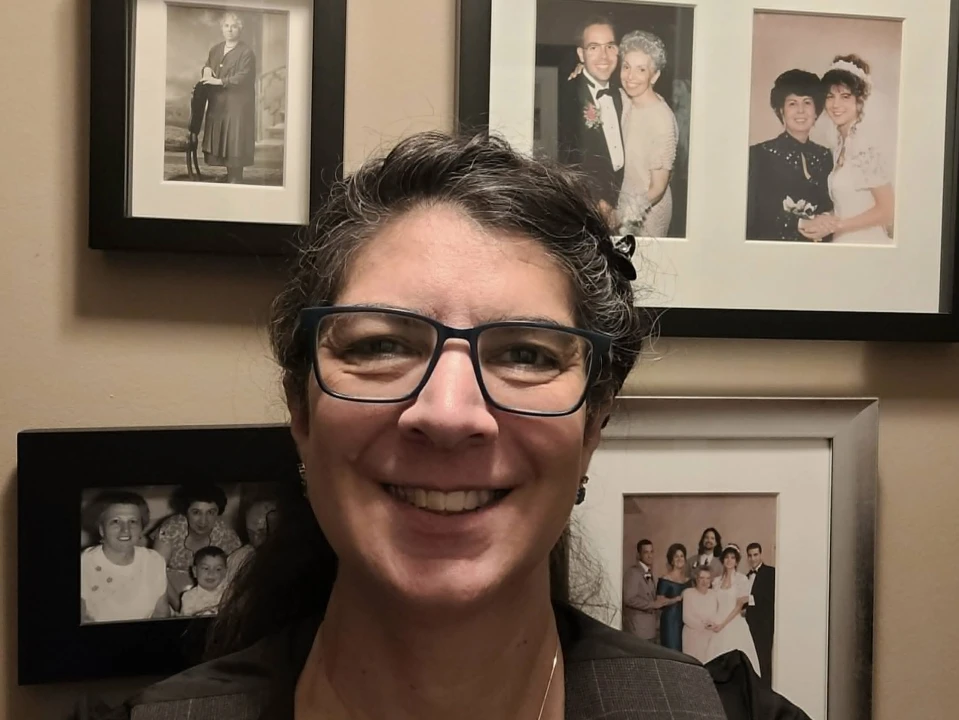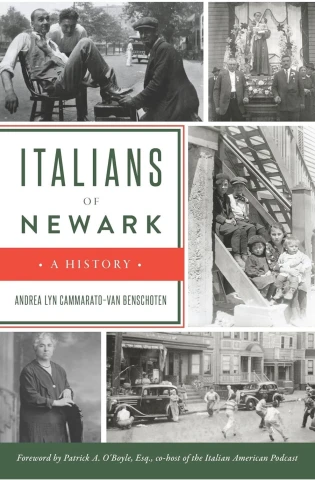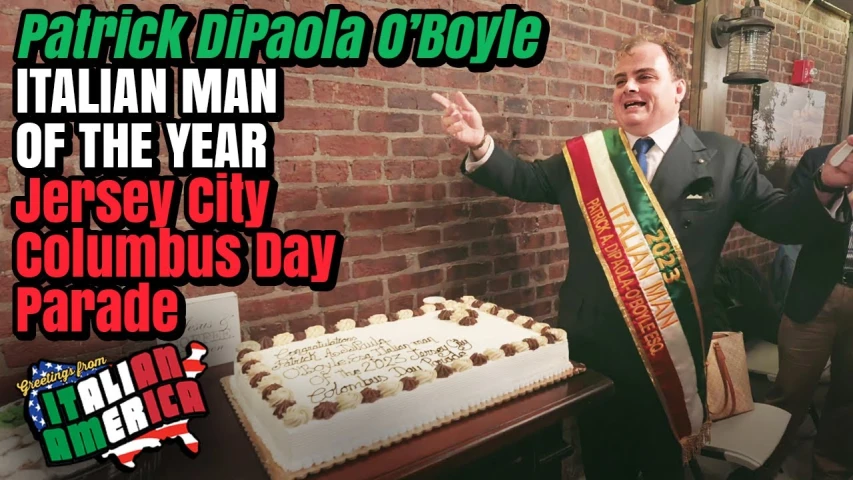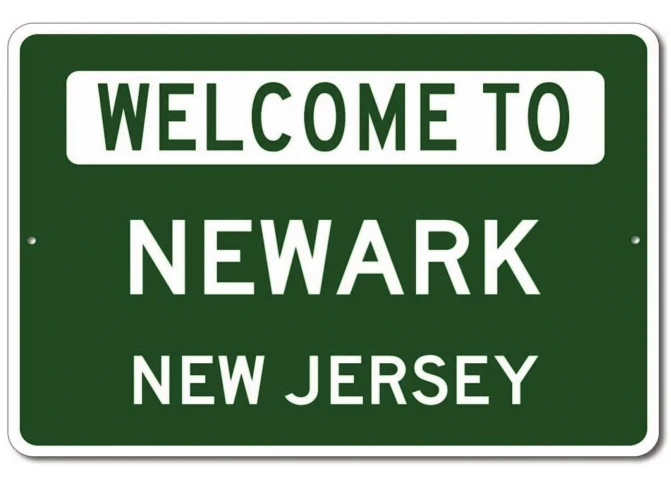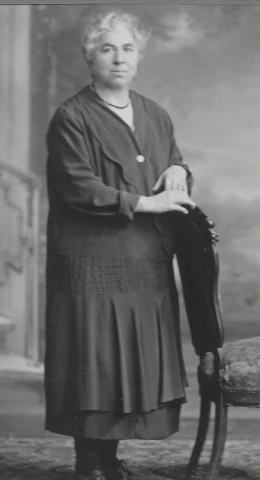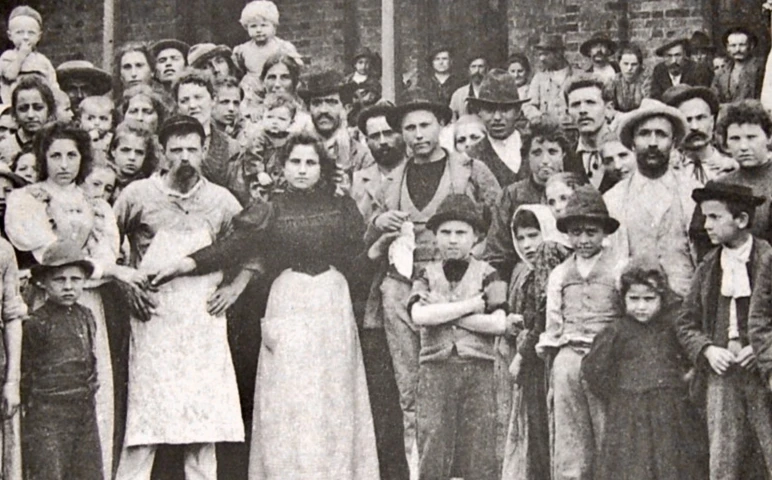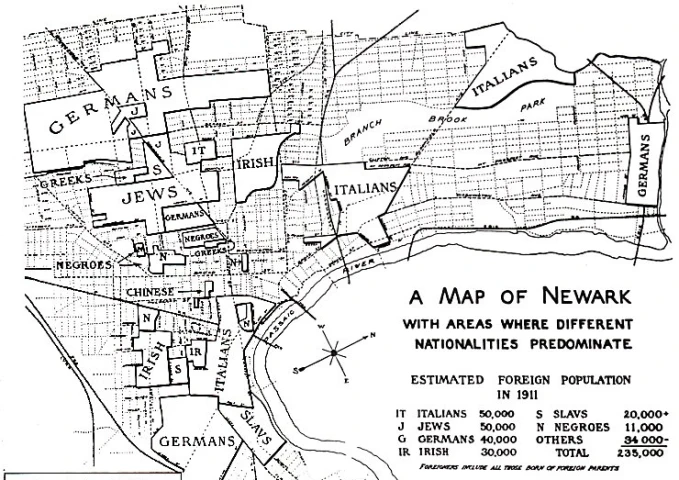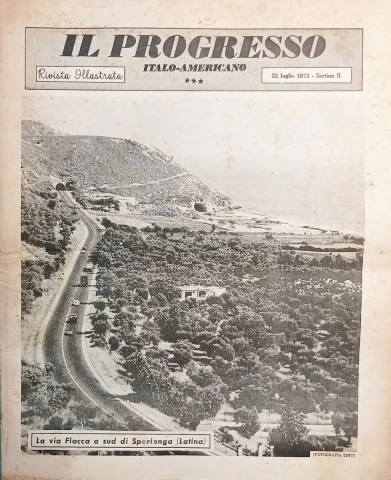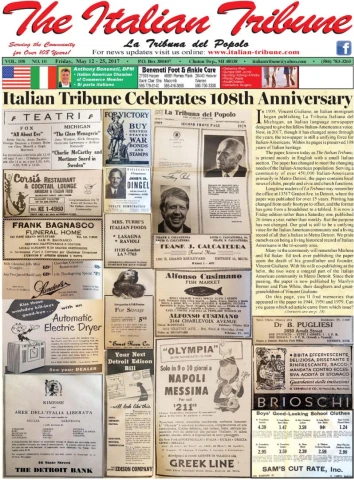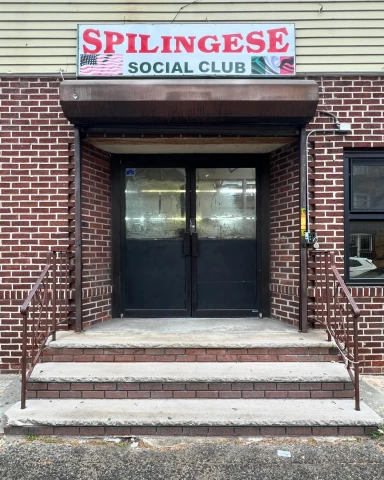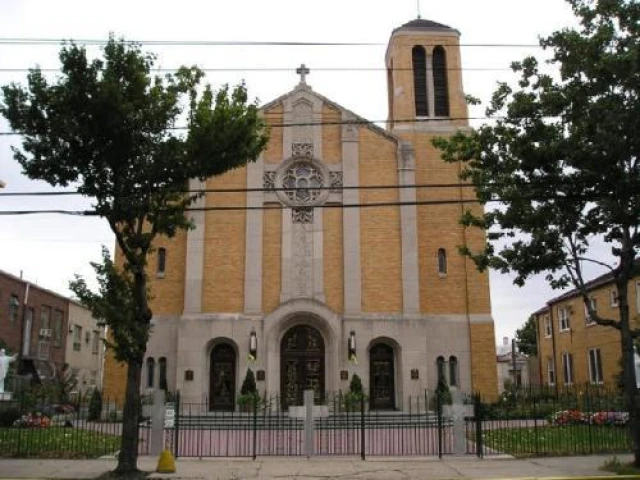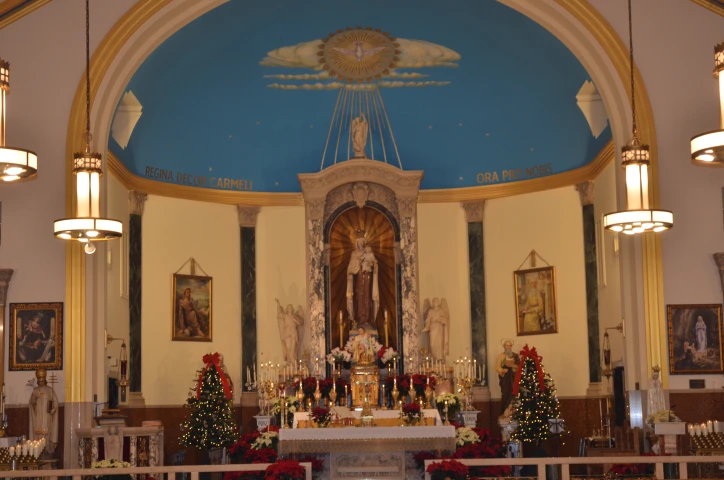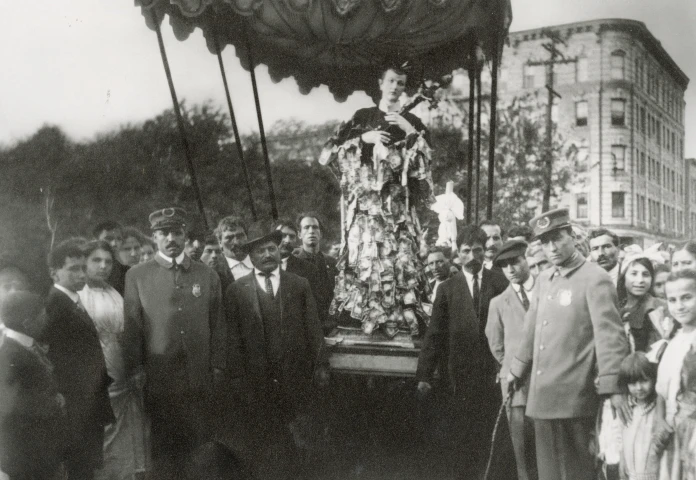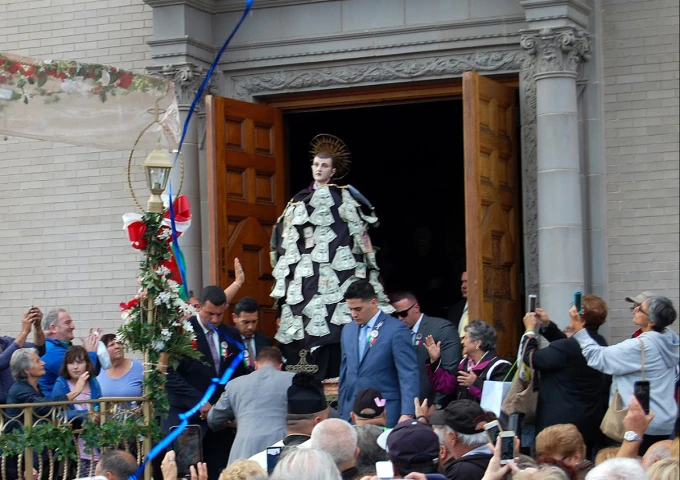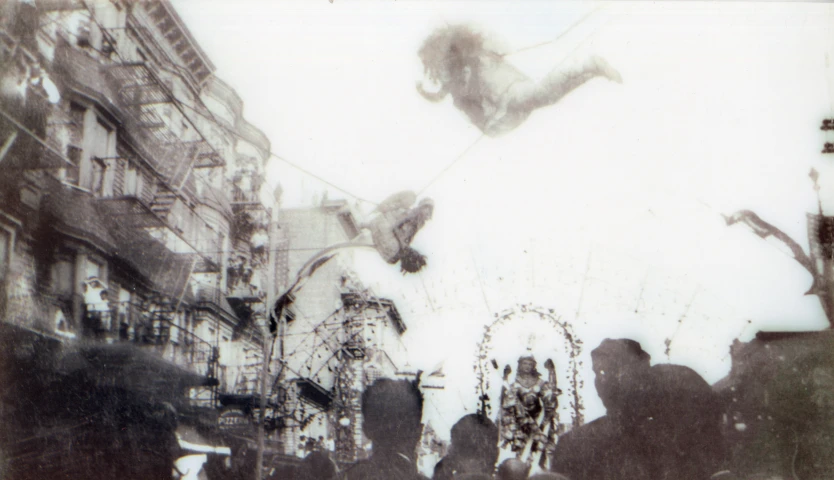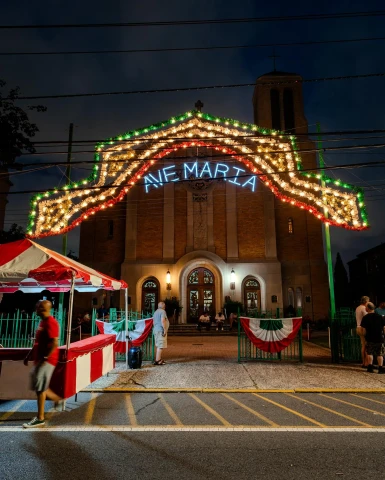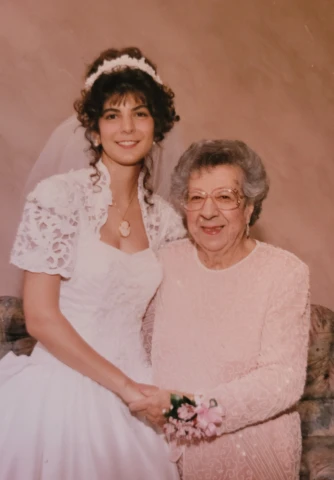Until a few years ago there were ten Italian Consulates in the United States, because there was also one in New Jersey, in Newark. It was a very bad choice to close it ten years ago, in my opinion, because the area is very populated with Italians and Italian Americans, and the two Consulates in New York and Philadelphia, which had to share the responsibilities of the one that was closed, were already overworked.
But what is the history of Italians in Newark? This is covered in a fine book that has just come out, written by an Italian American who is proud of her origins, Andrea Cammarato-Van Benschoten, who takes us on a journey of discovery of Italian-ness in this part of the Garden State.
https://podcasters.spotify.com/pod/show/umberto-mucci1/episodes/Italians-of-Newark-A-History-told-by-a-Jersey-Girl-with-Italian-roots-e2pduca
Hi Andrea, welcome to We the Italians. Please tell us something about your Italian roots
Thank you very much Umberto. And thank you for being such a wonderful advocate for the Italian American community!
The first in my family to reach the United States was my great-grandfather, Gabriele Ficetola, documented as Gabriel E. Fucetola when he arrived at Ellis Island in 1888. He was born in Calabritto in 1856. He and his wife, Lucia, made their home together in the First Ward of Newark. My other set of great-grandparents on my mother’s side, Ettore Victor and Rosaria Fieramosca, arrived in 1899 and also made their home in the First Ward. On my father’s side of the family, my great-grandparents, Michele and Angelina Palmieri, also immigrated from Calabritto. My fourth set of great-grandparents, Santo and Concetta Cammarato immigrated from Sicily. They all settled in the Old First Ward of Newark. An area a little less than one square mile but grew to be the largest Little Italy in New Jersey.
After opening your blog “Jersey Girl, Italian Roots”, you are about to publish your first book: “Italians of Newark”, with a foreword of my dear friend Patrick A. O’Boyle, Esq. Please tell us about the blog and the book…
Pat has been a huge point of support for me throughout the process. We immediately connected as fellow North Jerseyans. It turns out we grew up only a few towns away from each other. His stories of the special relationship he had with his grandmother really reminded me of the love and admiration I have always had for my grandmother. She was a huge inspiration for me. I asked him to write the forward and I was incredibly grateful when he agreed.
My first blog was originally about my beloved state of New Jersey. I started it to fight the negative stereotypes that developed when the shows Jersey Shore and Real Housewives of New Jersey hit the airwaves. As I continued to write, I found myself writing more and more about my Italian heritage and the important role it played in my upbringing. New Jersey has always been a state with strong Italian-American communities.
That combination of Italian heritage coupled with New Jersey pride makes for a unique combination. That brought me to create a completely separate blog focused on my heritage called Jersey Girl Italian Roots. I share stories about growing up as an American of Italian descent and how our community has evolved in New Jersey. I write not just about my family, but the other important achievements our community has made to our state as well as our entire country. I feel it is important to share all the positive contributions of our community as well as fighting the negative stereotypes you often see in American media.
The first chapter of the book is about “The History of the Great Migration 1880-1920”
I wanted to really take a look at the “why” behind this mass migration. Why would millions of people living in the same communities and villages for generations take such a huge risk and leave all they loved and knew behind? Many of them never saw their loved ones again. As someone who has trouble moving from one town or county to another, I live about an hour away from where I was born and grew up, I can’t imagine moving to an entirely new country with almost no money, no language skills, and rarely any formal education. These immigrants did not just survive but thrived. Theirs is a story of grit and determination that is to be admired and deserves to be told.
Then the book talks about “Discrimination against “I”-talians and Americanization”
As I continued my research, I began to learn the depths of discrimination Italian immigrants encountered when they arrived. It left me feeling both frustrated and sad. From the pejorative terms that were used to describe them, to the stereotype of a Mafia connection that was associated with every Italian immigrant, to the treatment they received during World War II, it is amazing they were able to overcome so many challenges. I admire their fortitude even more after learning so much about what they faced.
The federal government with support from special interest groups were successfully able to pass legislation several times to greatly curtail the influx of Italian immigrants. In the mid-1920s, the spigot was almost completely turned off – and kept that way – until the mid-1960s.
One story I learned about in my own family was the treatment of my great-grandmother, Concetta Zinna-Cammarato, who was required to register as an Alien of Enemy Nationality. An illiterate woman who never held a job and never moved out of the First Ward of Newark, was interviewed multiple times during and after World War II in search of ties to the enemy in Italy, of which she had none. I was able to attain this information through a request for her immigration file from the National Archives Immigration Database. In addition to receiving her registration file, I received another document that was dated several years later when she was investigated again. This time for moving without notifying the Department of Justice’s Immigration and Naturalization Service of the planned move. She moved just a few blocks over, still within the neighborhood of the First Ward. She was fingerprinted and her photo taken. That headshot is the only photo I have ever seen of her. I can’t tell you how long I stared at that grainy photograph and trying to think about what must have been going through her mind. Her son, my great-uncle Anthony, accompanied her on every appointment and had to sign for her, as she couldn’t even sign her own name. Next to his signature would only be a cross with the notation “her mark.” I just can’t imagine how it affected her. My heart just broke as I learned about her story and how thousands of immigrants just like her were treated.
Three chapters of your book are about “The Neighborhood: The Old First Ward, The Ironbound/Down Neck, Other Italian Immigrant Communities in Newark”
While the Old First Ward was the largest Little Italy in Newark, as well as all of New Jersey, there were several other Italian immigrant neighborhoods within the city’s border. For example, the Ironbound, also known as “Down Neck,” was initially settled around River and Mulberry Streets. However, this neighborhood suffered the same fate as the First Ward and the Italian immigrants were displaced to eminent domain in order to build Penn Station. They eventually found their way toward Ferry Street. That enclave remained in place for several decades.
Another Italian immigration neighborhood developed in the 14th Ward of Newark and grew large enough to require its own church. Unfortunately, just as the other Italian neighborhoods were displaced, the 14th Ward Italian neighborhood suffered a great tragedy when 14 members of the community were killed in a fire.
What about the “Information for the Community: Newspapers”?
The Italian communities of Newark were very lucky to have a few strong sources of news and information for an extended period of time, including Il Progresso Italo-Americano and The Italian Tribune. I remember seeing them for sale at the bakery on Sundays. I still get The Italian Tribune, even though I get it delivered now.
The last three chapters of the book are about three very fundamental topics of every Italian enclave in the US. Please tell us about “The Role of Social Clubs and Mutual Aid Societies”
Social clubs and mutual aid societies were crucial for newly arrived Italian immigrants. They not only provided a place for camaraderie, playing bocce, cards, and even American baseball, they provided important financial and social support for those struggling with health issues, loss of work, and even death benefits. My Uncles belonged to the Tacoma Club and all enjoyed playing cards there. We grew up hearing a story about a member of our family who had two bands when she passed away because she belonged to multiple societies. They were often focused around the neighborhood’s church, as well as the villages they emigrated from in Italy. Of all of them, almost none remain today. The Spilingese Social Club remains an active organization in the Ironbound, just down the street of Our Lady of Mount Carmel.
I guess that “The Importance of Family and Food” was not small in the Italian American community of Newark, am I right?
It was an absolutely huge part of the community. Everyone I spoke with for the book had a story about Sunday dinner, a holiday meal, or cooking with grandma. These were some of their most powerful memories. Many of the favorite dishes were often the simplest meals with inexpensive ingredients. We had no idea they were not considered authentic Italian dishes. We just knew our grandmother or mother made them for us with love and they hold a special place in everyone’s hearts. I know of no Italian American kid that didn’t get pastina made by grandma when they were sick. Many would joke and call is “Italian penicillin!”
The other common theme when it came to food was the lack of documented recipes. When those immigrants came to America, they simply adapted their original simple meals to the new ingredients available to them. So when a son or daughter wanted to learn a recipe, it was always a challenge. The concept of “one cup” or “two teaspoons” didn’t exist. You do your best and begin to write down what grandma was doing. You try to discern exactly what “a handful of flour” equates to in terms of cups. Then half-way through the process, she decides to add “a little more flour.” Well, exactly how does that “little more” plus the original “handful” total? There was always a bit of approximation. What I decided to do was document some of my most favorite recipes I grew up enjoying and I have shared them in the book; as best as possible that is.
Last but not least, “The Role of the Church”
This chapter required the most research and time. It was incredibly important to me that I document as much as possible and that all the information was accurate. I grew up going to St. Lucy’s in the Old First Ward for the Feast of St. Gerard and knew of Our Lady of Mount Carmel in the Ironbound. However, there were other churches specifically for the Italian community. Each church represented the heart of its neighborhood in Newark. Sadly, several of these special places are no longer in existence. I also learned about the lack of acceptance Italian immigrants faced when they first arrived. I had heard the term “basement Catholics” periodically when I was younger, however, I never knew it was literally how Italian immigrants were treated. They were relegated to the basements of the established Catholic parishes. Their form of worship was not acceptable to the Catholic Church establishment. However, they did not give up on their celebration of patron saints and feats. It took time for these immigrant communities gain acceptance and receive the spiritual support they needed.
Mother Cabrini also played a key role caring for the children in the Ironbound where she established the first school for the children of Italian immigrants. She was able to expand the school and educate hundreds of children. Unfortunately, the property was commandeered to build what is now known as Penn Station. But her legacy and a strong devotion to her remains in the Ironbound at Our Lady of Mount Carmel.
Almost every weekend from spring to fall, there was some kind of feast taking place in one of the Italian neighborhoods and they lasted for days. For example, many told me about the “flight of the angels” during the Feast of St. Michael, where little girls dressed as angels were pulled on ropes high above the street as St. Michael passed. The two feasts that remain are Our Lady of Mount Carmel in July and the Feast of St. Gerard at St. Lucy’s in October.
The three themes that I identified throughout my research were faith, family, and food. And it was at the feasts all three of those themes came together. All the research I did really gave me a deeper sense of faith and an even greater appreciation for all my ancestors endured so that I can live the life I have today. I am keenly aware I stand on their shoulders and do my best to honor them every day. I was taught at an early age to “never forget where you came from.” To recognize I am an American first, but my heritage continues to play a vital role in who I am. I can’t even put into words the respect I have for this community and the opportunities it has afforded the descendants of those original immigrants that arrived here 100 years ago with nothing more than a few dollars in their pocket, their faith, and a willingness to work hard. Everything was against them, yet they became a thriving and successful community. I can only hope to carry on as best I can in their honor.
Fino a qualche anno fa i Consolati italiani negli Stati Uniti erano dieci, perché ce n’era uno anche in New Jersey, a Newark. Fu una scelta molto sbagliata chiuderlo dieci anni fa, a mio avviso, perché l’area è molto popolata di italiani ed italoamericani, e i due Consolati di New York e Philadelphia, che si sono dovuti dividere le competenze di quello che è stato chiuso, erano già oberati di lavoro.
Ma qual è la storia degli italiani a Newark? Ne parla un bel libro appena uscito, scritto da una italoamericana orgogliosa delle sue origini, Andrea Cammarato-Van Benschoten, che ci accompagna alla scoperta dell’italianità in questa parte del Garden State.
Ciao Andrea, benvenuta su We the Italians. Raccontaci qualcosa delle tue radici italiane
Grazie mille Umberto. E grazie per essere un meraviglioso sostenitore della comunità italoamericana!
Il primo della mia famiglia a raggiungere gli Stati Uniti fu il mio bisnonno, Gabriele Ficetola, documentato come Gabriel E. Fucetola quando arrivò a Ellis Island nel 1888. Era nato a Calabritto nel 1856. Lui e sua moglie, Lucia, si stabilirono insieme nel First Ward di Newark. L'altra coppia di bisnonni da parte di mia madre, Ettore Victor e Rosaria Fieramosca, arrivò nel 1899 e anche loro si stabilirono nel First Ward. Anche i miei bisnonni paterni, Michele e Angelina Palmieri, immigrarono da Calabritto. Il mio quarto gruppo di bisnonni, Santo e Concetta Cammarato, immigrò dalla Sicilia. Si stabilirono tutti nella Old First Ward di Newark. Un'area di poco meno di un miglio quadrato, ma cresciuta fino a diventare la più grande Little Italy del New Jersey.
Dopo aver aperto il tuo blog “Jersey Girl, Italian Roots”, hai pubblicato il tuo primo libro: “Italians of Newark”, con la prefazione del mio caro amico Patrick A. O'Boyle, Esq. Parlaci del blog e del libro...
Pat è stato un enorme aiuto per me durante tutto il processo. Siamo entrati subito in sintonia come abitanti del North Jersey. Abbiamo scoperto di essere cresciuti a poche città di distanza l'uno dall'altro. I suoi racconti sul rapporto speciale che aveva con sua nonna mi hanno ricordato l'amore e l'ammirazione che ho sempre avuto per mia nonna. È stata una grande fonte di ispirazione per me. Gli ho chiesto di scrivere la prefazione e gli sono stata incredibilmente grata quando ha accettato.
Il mio primo blog era originariamente dedicato al mio amato Stato del New Jersey. L'ho aperto per combattere gli stereotipi negativi che si sono sviluppati quando i programmi Jersey Shore e Real Housewives of New Jersey sono andati in onda. Continuando a scrivere, mi sono ritrovata a parlare sempre più delle mie radici italiane e del ruolo importante che hanno avuto nella mia educazione. Il New Jersey è sempre stato uno Stato con forti comunità italoamericane.
La combinazione di eredità culturale italiana e orgoglio del New Jersey è una combinazione unica. Questo mi ha portato a creare un blog completamente separato incentrato sulle mie origini, chiamato Jersey Girl Italian Roots. Condivido storie sulla mia crescita come americana di origine italiana e su come la nostra comunità si è evoluta nel New Jersey. Non scrivo solo della mia famiglia, ma anche delle altre importanti conquiste che la nostra comunità ha fatto per il nostro Stato e per l'intero Paese. Ritengo importante condividere tutti i contributi positivi della nostra comunità e combattere gli stereotipi negativi che spesso si vedono nei media americani.
Il primo capitolo del libro è dedicato alla storia della grande migrazione dal 1880 al 1920...
Ho voluto analizzare il “perché” di questa migrazione di massa. Perché milioni di persone che vivevano da generazioni nelle stesse comunità e negli stessi villaggi avrebbero dovuto correre un rischio così grande e lasciare tutto ciò che amavano e conoscevano? Molti di loro non hanno mai rivisto i propri cari. Come persona che ha difficoltà a spostarsi da una città o da una contea all'altra, vivo a circa un'ora di distanza dal luogo in cui sono nata e cresciuta, non riesco a immaginare di trasferirmi in un Paese completamente nuovo con quasi zero soldi, nessuna conoscenza della lingua e raramente un'istruzione formale. Questi immigrati non si sono limitati a sopravvivere, ma hanno prosperato. La loro è una storia di grinta e determinazione che va ammirata e merita di essere raccontata.
Il libro parla poi della discriminazione contro gli “I-talians” e della loro americanizzazione
Continuando la mia ricerca, ho iniziato a conoscere le profonde discriminazioni che gli immigrati italiani incontravano al loro arrivo. Mi ha lasciato un senso di frustrazione e di tristezza. Dai termini peggiorativi che venivano usati per descriverli, allo stereotipo di un legame con la mafia che veniva associato a ogni immigrato italiano, al trattamento ricevuto durante la seconda guerra mondiale, è sorprendente che siano stati in grado di superare così tante sfide. Ammiro ancora di più la loro forza d'animo dopo aver appreso molto di ciò che hanno dovuto affrontare.
Il governo federale, con il sostegno di gruppi di interesse particolari, riuscì ad approvare più volte una legge per limitare notevolmente l'afflusso di immigrati italiani. A metà degli anni Venti, il “rubinetto” fu quasi completamente chiuso - e così rimase - fino alla metà degli anni Sessanta.
Una storia che ho appreso nella mia famiglia è il trattamento riservato alla mia bisnonna, Concetta Zinna-Cammarato, che fu obbligata a registrarsi come straniera di nazionalità nemica. Una donna analfabeta che non aveva mai avuto un lavoro e non si era mai mossa dal First Ward di Newark, fu intervistata più volte durante e dopo la Seconda Guerra Mondiale alla ricerca di legami con il nemico in Italia, che non aveva più. Sono riuscita a ottenere queste informazioni grazie alla richiesta del suo fascicolo di immigrazione al National Archives Immigration Database.
Oltre a ricevere il suo fascicolo di registrazione, ho ricevuto un altro documento datato diversi anni dopo, quando è stata nuovamente indagata. Questa volta per essersi trasferita senza aver notificato al Servizio Immigrazione e Naturalizzazione del Dipartimento di Giustizia il trasferimento previsto. Si era trasferita a pochi isolati di distanza, sempre nello stesso quartiere. Le furono prese le impronte digitali e le fu scattata una foto. Quella foto è l'unica che ho visto di lei. Non so dirti quanto a lungo ho fissato quella foto sgranata cercando di pensare a ciò che doveva passarle per la testa. Suo figlio, il mio prozio Anthony, l'accompagnava a ogni appuntamento e doveva firmare per lei, dato che non poteva nemmeno firmare con il proprio nome. Accanto alla sua firma c'era solo una croce con l'annotazione “il suo marchio”. Non riesco a immaginare come questo l'abbia colpita. Mi si è spezzato il cuore quando ho saputo della sua storia e di come sono stati trattati migliaia di immigrati come lei.
Tre capitoli del tuo libro riguardano il quartiere: l'Old First Ward, l'Ironbound/Down Neck e altre comunità di immigrati italiani a Newark
Mentre l'Old First Ward era la più grande Little Italy di Newark e di tutto il New Jersey, c'erano molti altri quartieri di immigrati italiani all'interno della città. Ad esempio, l'Ironbound, noto anche come “Down Neck”, era inizialmente insediato intorno alle vie River e Mulberry. Tuttavia, questo quartiere subì la stessa sorte del First Ward e gli immigrati italiani furono costretti a subire l'esproprio per la costruzione della Penn Station. Alla fine si diressero verso Ferry Street. Questa enclave rimase in piedi per diversi decenni.
Un altro quartiere di immigrati italiani si sviluppò nel 14° distretto di Newark e crebbe abbastanza da richiedere una propria chiesa. Sfortunatamente, proprio come gli altri quartieri italiani furono sfollati, il quartiere italiano del 14° distretto subì una grande tragedia quando 14 membri della comunità furono uccisi in un incendio.
Che si può dire del capitolo sul ruolo dei mezzi di informazione come i giornali?
Le comunità italiane di Newark sono state molto fortunate ad avere alcune forti fonti di notizie e informazioni per un lungo periodo di tempo, tra cui Il Progresso Italo-Americano e The Italian Tribune. Ricordo di averli visti in vendita al panificio la domenica. Ricevo ancora The Italian Tribune, anche se ora mi viene consegnata a casa.
Gli ultimi tre capitoli del libro riguardano tre argomenti fondamentali per ogni enclave italiana negli Stati Uniti. Parlaci del ruolo dei circoli sociali e delle società di mutuo soccorso…
I circoli sociali e le società di mutuo soccorso furono fondamentali per gli immigrati italiani appena arrivati. Non solo offrivano un luogo di cameratismo, giocando a bocce, a carte e persino a baseball, ma fornivano anche un importante sostegno finanziario e sociale a coloro che erano alle prese con problemi di salute, perdita del lavoro e persino per le eredità. I miei zii appartenevano al Tacoma Club e tutti si divertivano a giocare a carte. Siamo cresciuti sentendo la storia di un membro della nostra famiglia che aveva due fasce quando morì perché apparteneva a più società. Spesso si concentravano intorno alla chiesa del quartiere e ai villaggi da cui erano emigrati in Italia. Di tutte, oggi non ne rimane quasi nessuna. Lo Spilingese Social Club rimane un'organizzazione attiva nell'Ironbound, proprio in fondo alla strada di Our Lady of Mount Carmel.
Immagino che l'importanza della famiglia e del cibo non fosse di poco conto nella comunità italoamericana di Newark, vero?
Era una parte assolutamente importante della comunità. Tutti quelli con cui ho parlato per il libro hanno raccontato una storia di cene domenicali, di pranzi festivi o di cucina con la nonna. Erano alcuni dei loro ricordi più forti. Molti dei piatti preferiti erano spesso le pietanze più semplici, con ingredienti poco costosi. Non avevamo idea che non fossero considerati autentici piatti italiani. Sapevamo solo che la nonna o la mamma li preparavano con amore e che occupavano un posto speciale nel cuore di tutti. Non conosco nessun bambino italoamericano che non abbia assaggiato la pastina fatta dalla nonna quando era malato. Molti scherzavano e la chiamavano “penicillina italiana”!
L'altro tema comune, quando si parlava di cibo, era la mancanza di ricette documentate. Quando gli immigrati sono arrivati in America, hanno semplicemente adattato i loro semplici piatti originali ai nuovi ingredienti a loro disposizione. Quindi, quando un figlio o una figlia volevano imparare una ricetta, era sempre una sfida. Il concetto di “una tazza” o “due cucchiaini” non esisteva. Si faceva del proprio meglio e si cominciava a scrivere quello che faceva la nonna. Cercavi di capire esattamente a cosa corrispondeva “una manciata di farina” in termini di tazze. Poi, a metà del processo, decidevi di aggiungere “un po' di farina in più”. Ebbene, come si calcolava esattamente il totale di quel “poco in più” più da aggiungere alla “manciata” iniziale? C'era sempre un po' di approssimazione. Ho deciso di documentare alcune delle mie ricette preferite che sono cresciute e che ho condiviso nel libro, per quanto possibile.
Ultimo ma non meno importante: il ruolo della Chiesa...
Questo capitolo ha richiesto il maggior numero di ricerche e di tempo. Per me era incredibilmente importante documentarmi il più possibile e che tutte le informazioni fossero accurate. Sono cresciuta andando a St. Lucy nell'Old First Ward per la festa di San Gerardo e conoscevo Our Lady of Mount Carmel nell'Ironbound. Tuttavia, c'erano altre chiese specifiche per la comunità italiana. Ogni chiesa rappresentava il cuore del proprio quartiere a Newark. Purtroppo, molti di questi luoghi speciali non esistono più. Ho anche imparato a conoscere la mancanza di accettazione degli immigrati italiani al loro arrivo. Avevo sentito periodicamente il termine “cattolici del seminterrato” quando ero più giovane, ma non sapevo che fosse letteralmente il modo in cui venivano trattati gli immigrati italiani. Erano relegati nei sotterranei delle parrocchie cattoliche. La loro forma di culto non era accettabile per l'establishment della Chiesa cattolica. Tuttavia, non rinunciavano alla celebrazione dei loro santi patroni. Ci volle del tempo perché queste comunità di immigrati venissero accettate e ricevessero il sostegno spirituale di cui avevano bisogno.
Madre Cabrini ebbe anche un ruolo fondamentale nell'assistenza ai bambini di Ironbound, dove fondò la prima scuola per i figli degli immigrati italiani. Fu in grado di ampliare la scuola e di educare centinaia di bambini. Purtroppo la proprietà fu requisita per costruire quella che oggi è conosciuta come Penn Station. Ma la sua eredità e la forte devozione nei suoi confronti rimangono nell'Ironbound, presso Our Lady of Mount Carmel.
Quasi ogni fine settimana, dalla primavera all'autunno, in uno dei quartieri italiani si svolgeva una qualche festa che durava giorni. Per esempio, molti mi hanno raccontato del “volo degli angeli” durante la festa di San Michele, in cui bambine vestite da angeli venivano tirate su corde in alto sulla strada al passaggio di San Michele. Le due feste rimaste sono quella di Our Lady of Mount Carmel, a luglio, e la festa di San Gerardo a Santa Lucia, a ottobre.
I tre temi che ho individuato nel corso della mia ricerca sono stati la fede, la famiglia e il cibo. Ed è stato proprio in occasione delle feste che tutti e tre questi temi si incontravano. Tutta la ricerca che ho fatto mi ha dato un senso di fede più profondo e un apprezzamento ancora maggiore per tutto ciò che i miei antenati hanno sopportato per permettermi di vivere la vita che ho oggi. Sono consapevole di essere sulle loro spalle e faccio del mio meglio per onorarli ogni giorno.
Mi è stato insegnato fin da piccola a “non dimenticare mai da dove vieni”. Riconoscere che sono prima di tutto un'americana, ma che il mio retaggio continua a giocare un ruolo fondamentale in ciò che sono. Non riesco nemmeno a esprimere a parole il rispetto che nutro per questa comunità e per le opportunità che ha offerto ai discendenti di quegli immigrati originari che arrivarono qui 100 anni fa con nient'altro che pochi dollari in tasca, la loro fede e la volontà di lavorare sodo. Tutto era contro di loro, eppure sono diventati una comunità florida e di successo. Posso solo sperare di continuare a fare del mio meglio in loro onore.


